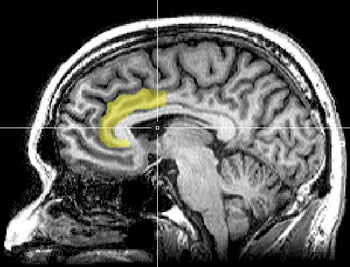Marker for Neuronal Damage Resolves a Year after Methamphetamine
Dr. Ruth Salo and colleagues at the University of California, Davis, extended previous findings that biochemical markers for nerve damage and viability persist in the brain through 6 months of abstinence from methamphetamine, but normalize after longer abstinence. In the new study, the researchers once again used proton magnetic resonance spectroscopy, imaging the brains of 30 former abusers of the stimulant who had been abstinent 1 to 6 months, 17 who had been abstinent 1 to 5 years, and 30 individuals who had never used the drug. As in the team’s two prior studies (see "Brain Recovery in Meth Abusers"; and "Methamphetamine Abusers Show Increased Distractibility"), the former abusers who had been abstinent for 6 months or less had reduced levels of N-acetyl aspartate (NAA), relative to creatine (Cr) levels, in the anterior cingulate cortex (ACC). NAA is produced in healthy neurons, and a low NAA/Cr ratio indicates neuronal injury or loss. In the new study, the ACC NAA/Cr ratio among the abusers who had been abstinent for a year or more was the same as in the group that had never taken the drug. These findings extend the previous results, which found evidence of choline normalization within the ACC.
 Operations Central Paying attention, making decisions, inhibiting responses, and detecting and controlling emotions all depend on the anterior cingulate cortex, shown in yellow in this magnetic resonance imaging slice. Credit: Geoff B. Hall/Wikimedia Commons.
Operations Central Paying attention, making decisions, inhibiting responses, and detecting and controlling emotions all depend on the anterior cingulate cortex, shown in yellow in this magnetic resonance imaging slice. Credit: Geoff B. Hall/Wikimedia Commons. “These scientific findings have clinical implications for substance abuse treatment programs,” says Dr. Salo. Although the new study did not include cognitive assessments, the researchers’ previous work demonstrated correlations between former stimulant abusers’ NAA/Cr ratios and their ability to accomplish a mental task in the presence of conflicting stimuli. Hence, patients in the early stages of treatment for stimulant abuse may require help to stay focused on recovery when they make decisions. Maintaining the recovery orientation may become easier as their length of abstinence passes half a year or longer.
Source
Drug and Alcohol Dependence 113(2-3):113-138, 2011 [Abstract]


